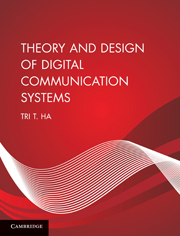Book contents
- Frontmatter
- Contents
- Preface
- Acknowledgements
- List of symbols
- List of abbreviations
- 1 Introduction
- 2 Deterministic signal analysis
- 3 Random signal analysis
- 4 Information theory and channel coding
- 5 Communication link analysis
- 6 Modulation
- 7 Demodulation
- 8 Spread spectrum
- 9 Intersymbol interference and equalization
- 10 Fading channels
- Index
- References
8 - Spread spectrum
Published online by Cambridge University Press: 05 June 2012
- Frontmatter
- Contents
- Preface
- Acknowledgements
- List of symbols
- List of abbreviations
- 1 Introduction
- 2 Deterministic signal analysis
- 3 Random signal analysis
- 4 Information theory and channel coding
- 5 Communication link analysis
- 6 Modulation
- 7 Demodulation
- 8 Spread spectrum
- 9 Intersymbol interference and equalization
- 10 Fading channels
- Index
- References
Summary
Introduction
A spread spectrum modulated signal has a bandwidth much larger than the bandwidth of its narrowband counterpart for transmitting the message signal. For example, a spread spectrum PSK signal employed in the forward link of the 2G cellular standard IS-95 carrying a coded message signal of symbol rate 19.2 ksps has a bandwidth of 1.25 MHz. The narrowband PSK signal would only require a bandwidth of 19.53 kHz. This is an increase of bandwidth by a factor of 64. What is the reason behind the use of spread spectrum modulation? Historically, spread spectrum modulation originated from military applications. The purpose is to protect the received signal's integrity by reducing the effectiveness of a jamming signal. In order to jam a spread spectrum signal, the jamming signal must distribute its fixed transmitted power over a larger spread bandwidth. This would lower the magnitude of its power spectral density and correspondingly its jamming power in the smaller message bandwidth. There are basically two types of spread spectrum modulated signals: direct sequence (DS) and frequency hop (FH).
Direct sequence modulation
In direct sequence modulation the data 0s and 1s of bit rate Rb = 1/Tb are used to modulate a periodic pseudo-noise (PN) sequence of N chip 0s and 1s. The chip rate is Rc = 1/Tc = NRb, and the sequence period is the same as the bit time.
- Type
- Chapter
- Information
- Theory and Design of Digital Communication Systems , pp. 432 - 472Publisher: Cambridge University PressPrint publication year: 2010

